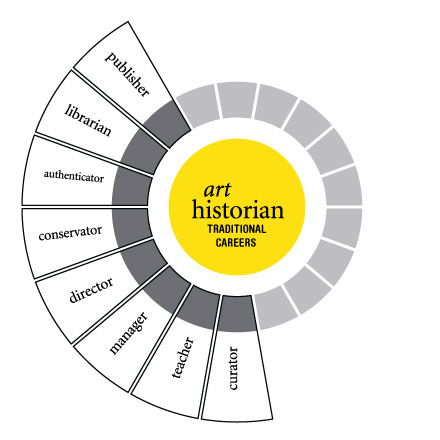How to Get Under the Skin of an Art Historian
The Top Eight Traditional Careers in Fine art History
Graduates of art history degree programs emerge primed for a broad range of careers in the fine art field and beyond. While many art historians choose self-employed fine arts jobs or nontraditional art history careers, the following sought-later on careers in art history correspond the top 8 traditional uses for an art history master'due south degree:

1. Curator
A curator oversees the collection, storage, and display of artworks, historical memorabilia, digital files, or artifacts. Depending upon the size of the organization, curators may be responsible for working with artists, collectors, donors, or other organizations to acquire artwork; documentation and storage; original research and publication; and creative display of works. Traditionally, curators work for museums, libraries, and other arts organizations. However, in contempo years this office has expanded to include business organization curators managing corporate memorabilia and art collections, curation for educational institutions, private foundation or personal drove curators, authorities curators working with public spaces, and independent, freelance curators.
2. Teacher
Art history educators share fine art knowledge in museum or academic settings. Depending upon the specific office and arrangement, level of audition, and specialty, art history educators may spend significant time conducting research, interacting with the public, or mentoring art students in the classroom.
3. Museum Administrator/Director
Museum directors carry ultimate responsibility for advancing their arrangement'south mission, artistic direction, collections, scholarship, and programs. The manager manages the museum'southward day-to-day operations. Similar curators, directors influence creative direction of the museum'due south exhibitions and oversee the collection, storage, and display of artworks. In addition, museum directors manage the administrative side of the organisation. An administrator's job typically includes a significant amount of fundraising, donor and community relations, financial and investment direction, hiring, and oversight of museum staff.
four. Conservator/Art Restorer/Conservation Scientist
Art conservators specialize in the preservation, intendance, and restoration of works of art. Conservators manage the condom storage and transportation of works, clarify the display environs, certificate and record current condition, and determine restoration efforts needed. Patience and attention to particular are critical in this role. Conservators typically choose an area of expertise, such every bit paper, textiles, painting, piece of furniture, or art objects. They often work closely with conservation scientists—chemists who business organisation themselves with the scientific elements at work in an art slice's environment and composition, and in the chemical components of the restoration and preservation process.
5. Art Authenticator
The sophistication of art forgers, the prevalence of art theft, and the unlawful transfer of artworks from war-torn countries means that potential art buyers and sellers often require the hallmark services of an art historian. Typically, authenticators specialize in a particular creative person or style, and must display substantial inquiry and investigative skills. Authenticators research the "provenance" of a work past tracing the path of ownership equally far dorsum as possible, work with other recognized experts, consult with artists' foundations, and contract scientific testing to determine the viability of the materials used.
six. Museum Reproductions/Retail Managing director
A museum reproductions role can involve museum store retail direction and decision-making regarding which artworks in the museum's collections should exist reproduced for sale. It may include working with artists and navigating copyright issues, design and creative decisions for the display and reproduction of the artwork in the retail setting, managing sales staff, and other duties related to running the retail arm of an arts organization.
7. Art Librarian/Visual Resource Curator
Visual resource curators and art librarians manage the cataloguing, documentation, storage, and retrieval of visual resource in art libraries, educational institutions, and for-profit organizations. In addition to expertise in the artwork itself, art librarians bring inquiry and technological skills to the role, along with the people skills necessary to work with the public and academicians every bit they access the works. In add-on to a graduate caste in art history, art librarianship roles may require graduate piece of work in library science.
8. Fine art Publishing
Academic, commercial, and independent fine art book publishing houses utilize a range of arts professionals in graphic design, writing, editing, and administrative roles. While entry level roles typically will non require a principal's degree, advancement in these roles often requires higher pedagogy in the arts, and these roles volition provide opportunities to explore and influence art history dialogue and interpretation.
nine. Auctioneer
An auctioneer represents the seller of a piece of art. The auctioneer must creatively describe the slice and create excitement during an sale in order to sell it for the highest price possible. Auctioneers often research item art pieces to gain knowledge almost the artwork itself, and additionally must have the ability to remain cool nether pressure, relate to fine art owners, and read a oversupply.
For more information, visit Azusa Pacific University's Online MA in Modern and Contemporary Art History.
For more careers in art history, bank check out these related resources:
- The Top Nine Nontraditional Art History Careers
- The Peak Seven Self-Employed Arts Jobs for Fine art Historians
Notation: This information is current for the 2021-22 academic twelvemonth; however, all stated academic data is subject to change. Please refer to the electric current Bookish Catalog for more data.
Source: https://www.apu.edu/vpa/programs/art-history-masters/careers/traditional/
0 Response to "How to Get Under the Skin of an Art Historian"
Post a Comment